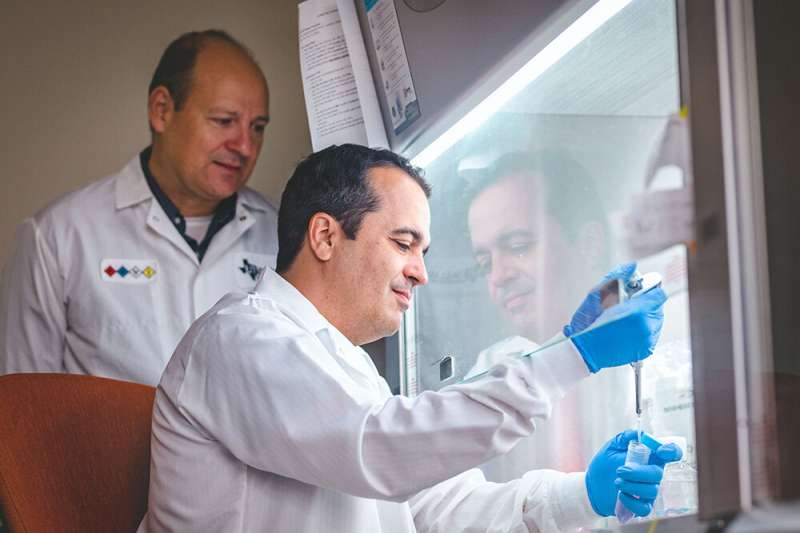[ad_1]

Innovations in synthetic biology and genome enhancing have led to a rising industry to establish custom made mobile lines for healthcare study. These engineered cell strains, even so, can be susceptible to misidentification, cross-contamination and illegal replication.
A group of University of Texas at Dallas scientists has developed a to start with-of-its-kind strategy to develop a unique identifier for each copy of a mobile line to enable consumers to verify its authenticity and safeguard the manufacturer’s mental assets (IP). The engineers demonstrated the system in a review revealed on the internet Might 4 and in the Might 6 print version of Science Advancements.
The patent-pending technology is the outcome of an interdisciplinary collaboration involving UT Dallas school members. The study’s co-corresponding authors are Dr. Leonidas Bleris, a professor of bioengineering who specializes in genetic engineering, and Dr. Yiorgos Makris, a professor of electrical and pc engineering who is an qualified on electronics hardware security.
Tailor made cell traces are made use of in the progress of vaccines and specific therapies for a variety of ailments. The worldwide mobile-tradition industry is projected to arrive at $41.3 billion by 2026, an maximize from $22.8 billion in 2021, in accordance to a forecast by industry investigation corporation MarketsandMarkets.
The UT Dallas engineers’ exploration to build one of a kind identifiers for genetically engineered cells was inspired by what are known as bodily unclonable features (PUFs) in the electronics industry. A PUF is a physical characteristic that can provide as a exceptional “fingerprint” for a semiconductor device this sort of as a microprocessor. In semiconductors, PUFs are dependent on natural variants that manifest in the course of the producing procedure and should meet up with a few specifications: They need to have a distinctive fingerprint, generate the very same fingerprint every time they are measured and be almost difficult to replicate.
To apply that concept to engineered cells, the researchers developed a two-stage procedure that takes gain of a cell’s potential to restore harmed DNA, which is made up of sequences of little molecules referred to as nucleotides.
Initially, they embedded a five-nucleotide bar-code library into a element of the cell’s genome named a safe and sound harbor, the place the modification will not harm the cell. The bar codes on your own, however, do not satisfy the 3 attributes of PUFs. In the second move, researchers utilized the gene-editing tool CRISPR to reduce the DNA in the proximity of the bar code. That motion forces the cell to mend its DNA utilizing random nucleotides, a system termed nonhomologous error maintenance. During this fix system, the cell normally inserts new nucleotides into the DNA and/or deletes others—collectively, these are named indels (insertions/deletions). These random fixes, in mixture with the bar codes, make a special sample of nucleotides that can help distinguish the mobile line from any other.
“The blend of bar-coding with the inherently stochastic cellular mistake restore method final results in a special and irreproducible fingerprint,” explained Bleris, who is also the Cecil H. and Ida Inexperienced Professor in Units Biology Science.
This initial technology of CRISPR-engineered PUFs supplies the indicates for researchers to affirm that the cells have been developed by a specified enterprise or lab, a approach identified as provenance attestation. With further more analysis, the engineers aim to develop a strategy for tracking the age of a certain duplicate of a cell line.
“Firms establishing cell strains are building a large financial investment,” Bleris reported. “We require a way to differentiate in between 1,000 copies of the same product or service. Even even though the products are similar, just about every of them has a exclusive identifier, which can not be replicated.”
Makris said that the company of establishing engineered cells is so new that firms are concentrated on monetizing their investments instead than on safety and provenance attestation. He stated the semiconductor marketplace was the same way at 1st till counterfeiting and tampering incidents highlighted the need for safety steps.
“We imagine that this time perhaps we can be forward of the curve and have that capability developed by the time the industry realizes they will need it,” Makris reported. “It will be far too late when they understand they acquired hacked and a person monetized their IP.”
Other authors of the research include Dr. Yi Li, bioengineering analysis scientist Mohammad Mahdi Bidmeshki Ph.D., a previous postdoctoral researcher in Makris’ lab Taek Kang, a biomedical engineering doctoral student and Eugene McDermott Graduate Fellow and Likelihood M. Nowak, a bioengineering graduate college student.
Really safe physically unclonable cryptographic primitives based mostly on interfacial magnetic anisotropy
Yi Li et al, Genetic actual physical unclonable capabilities in human cells, Science Advancements (2022). DOI: 10.1126/sciadv.abm4106
Citation:
New know-how protects authenticity of engineered mobile lines (2022, June 6)
retrieved 8 June 2022
from https://phys.org/information/2022-06-technological know-how-authenticity-mobile-strains.html
This document is subject to copyright. Aside from any fair dealing for the objective of non-public examine or research, no
component may perhaps be reproduced with out the written permission. The information is furnished for facts needs only.
[ad_2]
Source link






More Stories
The Information Technology Era
The Main Functions of Computer Memory
Save Money by Investing in Industrial Computer Enclosures That Increase the Lifespan of Computers